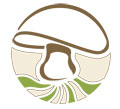Avon Heath Country Park
Sat 26 Apr 2008
Field event ID HF0801
OS Grid areas: SU1201 SU1202
Weather: After a week of mixed showers and sunshine the day was warm, almost hot (18C), with long periods of sunshine.
New Records:
New to HFRG: Lachnellula pseudofarinacea, Strobilurus stephanocystis, Scytinostroma ochroleucum.
Report: (Roger Newton:) The car park revealed a beautiful bunch of Calocybe gambosum (St Georges mushroom) (no more were found that day) and a large colony of Paxina acetabulum (Vinegar Cup) which exceeded 20 in number. Whilst the photographs were being taken Jacquey was getting to grips with the new clerical recording sheet which Alan has created and is going to patent! It proved an instant success enabling Stuart to foray for the first time in a long while, and is a system which will be able to be used by any group member on future forays. We were only just outside the car park when Sue stumbled across Paxina leucomelas perfectly camouflaged in the grey sandy soil, which were some how missed by the younger and better sighted members of the group. Sara’s effort in dragging a six foot pine branch to each member in turn was finally rewarded when Alan took pity on her and identified Exidia saccharina. Following on from finding Lachnellula pseudofarinacea a few days earlier Alan found this minute cup fungus once more on a pine branch near where resin was exuding whilst Jean Paul and Roger found rabbit eaten but, still beautiful, specimens of Anacamptis morio (Green winged orchid). On finding an unknown fungi cohabiting with Trichaptum abietinum (the latter had been found for the umpteenth time) Alan did a classic French shrug of his shoulders and said “Can I be bothered to take another one home?” to which Jacquey curtly replied in her school teacher manner, “If you don’t, it will be a rare and unusual one!” and guess who was right? It was the rare Skeletocutis carneogrisea of which there are only two existing Hampshire records. Other notable species found were Lycogola terrestre and epidendrum which sparked discussions as to which were which, and left us all to do some further homework; and both the scented Clitocybe fragrans (Fragrant funnel) and the spring Clitocybe sinopica usually found on firesites.
Species list: Aleurodiscus aurantius, Annulohypoxylon multiforme, Auricularia auricula-judae, Beauveria bassiana, Byssomerulius corium, Calocybe gambosa, Chaetosphaerella phaeostroma, Cheilymenia fimicola, Clitocybe fragrans, Clitocybe sinopica, Daedaleopsis confragosa, Datronia mollis, Diatrypella favacea, Entoloma cetratum, Exidia saccharina, Fuscoporia ferrea, Ganoderma australe, Gloeoporus taxicola, Helvella acetabulum, Helvella leucomelaena, Hyphoderma argillaceum, Hyphodontia alutaria, Lachnellula pseudofarinacea, Lachnum niveum, Lachnum virgineum, Lycogala epidendrum, Lycogala terrestre, Lycoperdon perlatum, Peniophora incarnata, Peniophora lycii, Peniophora quercina, Piptoporus betulinus, Psathyrella spadiceogrisea, Schizophyllum commune, Schizopora paradoxa, Scytinostroma ochroleucum, Skeletocutis carneogrisea, Strobilurus stephanocystis, Trametes versicolor, Tremella mesenterica, Trichaptum abietinum, Trichoderma pulvinatum
